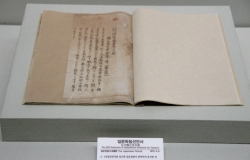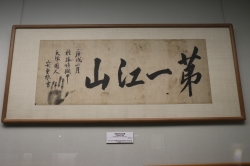March 1st marks the 3.1 Independence Movement Day, a national holiday for the Republic of Korea, which
declared its independence against Japanese imperialism during the Japanese colonial era. It is a meaningful day
for our country. Let’s find out about the person who contributed to the first verse, and the traces of SSU in the third
verse. ..............................................................................................................Ed
The 3.1 Independence Movement Day is a holiday that any Korean citizen knows. It is a day the independence activists and Koreans all over the world rose against the colonial oppression of Japanese rule. It is also the day when 33 national representatives declared the eternal independence of Korea via the Independence Declaration. The 3.1 Independence Movement is even enshrined in the Republic of Korea’s Constitution as the foundation of Korean nationhood, both in spirit and in body. To commemorate this event, ST has prepared a special article about the 3.1 Independence Movement Day and its history, as well as the independence activists of Soongsil University, especially how they shaped the anti-Japanese struggle.

- The history of the 3.1 Independence Movement Day
The history of the 3.1 Independence Movement Day begins the very year after the Movement itself. The 3.1 Independence Movement sparked the seed of national independence activities everywhere, and some leaders of the movement would soon establish the KPG (Provisional Government of the Republic of Korea) in Shanghai. To commemorate the first anniversary of the Movement, the Korean people of Shanghai, as well as the KPG, would celebrate and hang the flag of Korea in their homes, a proud tradition that continues to this day. The celebrations were not limited to Shanghai; Korean communities everywhere celebrated the anniversary as well, including communities in the US, Russia, Cuba, and even Japan itself.
After Japan’s surrender and Korea’s independence, the newly established Democratic Council of Korea enshrined the 3.1 Independence Movement Day as a national holiday. Then, after the establishment of the Republic of Korea in 1948, the day was included in the four great holidays, as the foundation of the republic itself.

- The Independence Activists who served Korea
The Korean Independence Movement could not have gotten as far as it could have, without the brave individuals that served the Movement. One of the most well-known activists would be Yoo Guan-soon, a young female student who participated in the 3.1 protests. An alumna of the Ewha school, an all-girls school which would become the Ewha Women’s University, she was arrested by the Japanese colonial government and was imprisoned. After a sham trial that had her sentenced to five years, a prison sentence even the Japanese legal system relented as unusually high on appeal, she was imprisoned in the infamous Seodaemun Prison, where many political activists were held. She bravely withstood the brutal torture that the Japanese military police subjected her to, but she unfortunately passed away in prison as a result on September 28, 1920, at the young age of 17. Her memory, however, lived on, and she is one of the most remembered activists of the 3.1 protests.

- Activists of SSU
Resisting the forced Shinto worship of SSU by the Japanese
SSU is the only university in Korea to resist forced Shinto worship during the Japanese colonial period. Forced Shinto worship is an activity the Japanese had forced upon Koreans in order to suppress our religious and ideological freedom during the Japanese colonial era. SSU actively participated in the anti-Japanese movement such as the “105-Man Incident,” which was suppressed by the Japanese Empire. The Japanese Empire carried out a blatant crackdown by demoting SSU to Soongsil College. SSU, which was established in Pyongyang in 1897, decided to close the school rather than participate in the forced worship, when Japan forced Joseon’s educational institutions to worship the shrines, and pushed ahead with the voluntary closure of the school on March 18, 1938, the only school to do so in the country. By voluntarily closing the school in response to the compulsion to visit the shrine, we kept our national pride and religious belief. The historical symbol of SSU’s voluntary shutdown can also be found on campus. The white horse, the symbol of SSU, shows that SSU inherited the spirit of Goguryeoans, who had ridden freely across their vast land. The broken middle part of the white horse statue in SSU is a sign of the proud history of SSU’s voluntary closure during the Japanese colonial era in 1938.
Soongsilians
To mark the 120th anniversary of its foundation, SSU carried out a project to discover independence activists from Soongsil. A total of three Soongsilians were chosen as persons of merit in the independence movements of the National Liberation Day in 2017. The Korean Christian Museum investigated those who participated in the independence movement to discover independence activists from Soongsil, and to recommend them to the Ministry of Patriots and Veterans Affairs to be recognized as such. Three Soongsilians who were recommended to the Ministry for Patriots and Veterans Affairs as independence activists are Kim Yang-sun, who participated in the anti-Japanese movement, joining the secret society, ”Cheongguhoe,” and resisting the forced Shinto worship, Kim Hyung-doo, who participated in the student demonstration in Pyongyang in January 1930 to sympathize with the Gwangju Student Independence Movement, and Kim Tae-sul, who participated in the 3.1 Independence Movement in Pyongyang. Due to the efforts of the Korean Christian Museum, three more activists could be properly recognized in addition to the
41 independence activists from SSU who were already recognized, bringing the total to 44.
SSU is the only domestic university that voluntarily chose to shut its doors against the Japanese colonial oppression. ST hopes
that Soongsilians will appreciate the program to find independence activists from SSU, and honor the spirit of self-sacrifice and
patriotism of Soongsilians who attended SSU during the darkest days of the Japanese occupation to mark the 104th year of the
Independence Movement Day.
Min Jeong-ung (News Editor)
redreboot@soongsil.ac.kr
Seo Min-ji (ST Reporter)
seomin2003@soongsil.ac.kr


